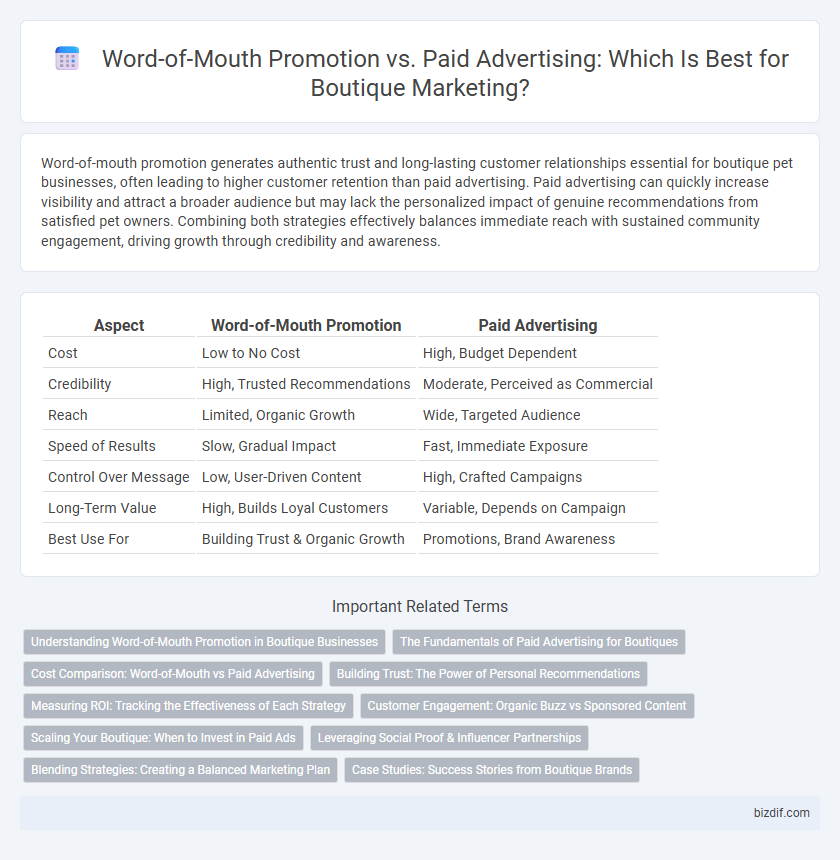Word-of-mouth promotion generates authentic trust and long-lasting customer relationships essential for boutique pet businesses, often leading to higher customer retention than paid advertising. Paid advertising can quickly increase visibility and attract a broader audience but may lack the personalized impact of genuine recommendations from satisfied pet owners. Combining both strategies effectively balances immediate reach with sustained community engagement, driving growth through credibility and awareness.
Table of Comparison
| Aspect | Word-of-Mouth Promotion | Paid Advertising |
|---|---|---|
| Cost | Low to No Cost | High, Budget Dependent |
| Credibility | High, Trusted Recommendations | Moderate, Perceived as Commercial |
| Reach | Limited, Organic Growth | Wide, Targeted Audience |
| Speed of Results | Slow, Gradual Impact | Fast, Immediate Exposure |
| Control Over Message | Low, User-Driven Content | High, Crafted Campaigns |
| Long-Term Value | High, Builds Loyal Customers | Variable, Depends on Campaign |
| Best Use For | Building Trust & Organic Growth | Promotions, Brand Awareness |
Understanding Word-of-Mouth Promotion in Boutique Businesses
Word-of-mouth promotion in boutique businesses leverages personalized customer experiences and authentic recommendations to build trust and community loyalty. Customers are more likely to share their positive interactions with unique products and exceptional service, driving organic growth without the high costs of paid advertising. This form of promotion enhances brand credibility and often results in higher conversion rates due to its genuine and relatable nature.
The Fundamentals of Paid Advertising for Boutiques
Paid advertising for boutiques involves strategically targeting a specific audience through platforms like social media, Google Ads, and influencer partnerships to maximize brand visibility and drive sales. By leveraging demographic data, customer behavior insights, and conversion tracking, boutiques can optimize ad spend and generate measurable results more efficiently than relying solely on word-of-mouth promotion. Effective paid campaigns incorporate compelling visuals, clear calls-to-action, and retargeting strategies to convert potential customers into loyal buyers.
Cost Comparison: Word-of-Mouth vs Paid Advertising
Word-of-mouth promotion incurs minimal direct costs, relying on satisfied customers to organically share their positive experiences, making it a highly cost-effective strategy for boutiques. Paid advertising demands a significant budget allocation for campaign creation, placement, and ongoing management across platforms like social media, search engines, and print media. While paid advertising offers immediate exposure, the sustainable, low-cost nature of word-of-mouth often results in a higher return on investment for boutique businesses.
Building Trust: The Power of Personal Recommendations
Word-of-mouth promotion significantly boosts trust in boutique brands by leveraging genuine customer experiences and personal recommendations, fostering long-lasting relationships. Unlike paid advertising, which can be perceived as intrusive, personal endorsements resonate more authentically and influence purchasing decisions effectively. Boutique owners benefit from nurturing satisfied customers who advocate for their products, enhancing credibility and driving organic growth.
Measuring ROI: Tracking the Effectiveness of Each Strategy
Measuring ROI in boutique marketing requires precise tracking of key performance indicators such as customer acquisition cost and lifetime value for both word-of-mouth promotion and paid advertising. Word-of-mouth can be assessed through referral codes, customer surveys, and social media engagement metrics, offering insights into organic brand advocacy and customer satisfaction. Paid advertising effectiveness is tracked via conversion rates, click-through metrics, and attribution models, providing concrete data to compare the cost-efficiency and impact of each marketing strategy on boutique sales growth.
Customer Engagement: Organic Buzz vs Sponsored Content
Word-of-mouth promotion fosters authentic customer engagement by encouraging organic buzz through genuine recommendations and personal experiences, which builds lasting trust and brand loyalty for boutiques. Paid advertising relies on sponsored content to reach a wider audience quickly but often lacks the emotional connection that drives deeper consumer involvement. Boutiques benefit most from a balanced approach where organic customer interactions amplify paid campaigns, enhancing overall engagement and conversion rates.
Scaling Your Boutique: When to Invest in Paid Ads
Scaling your boutique requires a strategic balance between word-of-mouth promotion and paid advertising to maximize growth and brand visibility. While word-of-mouth fosters authentic customer trust and organic growth, investing in paid ads becomes essential once your boutique reaches a repeat customer base of 1,000+ and aims to accelerate sales conversion through targeted campaigns. Paid advertising on platforms like Instagram and Facebook offers precise audience segmentation, driving scalable traffic and measurable ROI compared to the slower, less predictable reach of organic word-of-mouth.
Leveraging Social Proof & Influencer Partnerships
Word-of-mouth promotion leverages authentic customer experiences and social proof, driving trust and organic growth for boutiques by turning satisfied clients into brand advocates. Paid advertising, while effective for targeting specific demographics, often lacks the genuine endorsement found in influencer partnerships that amplify boutique visibility through trusted voices. Combining influencer collaborations with social proof optimizes marketing ROI by enhancing credibility and expanding reach within niche, style-conscious audiences.
Blending Strategies: Creating a Balanced Marketing Plan
Blending word-of-mouth promotion with paid advertising creates a balanced marketing plan that leverages authentic customer testimonials alongside targeted outreach campaigns. Word-of-mouth increases trust and brand loyalty, while paid advertising drives immediate visibility and measurable ROI. Effective boutique strategies integrate social proof with data-driven ads to optimize customer acquisition and retention.
Case Studies: Success Stories from Boutique Brands
Boutique brands have demonstrated significant growth through word-of-mouth promotion, with case studies showing a 30% increase in customer retention compared to paid advertising strategies. Success stories like Glossier reveal that authentic customer referrals generate higher trust and engagement, leading to organic sales surges without large marketing budgets. Paid advertising, while effective for initial brand awareness, often yields lower long-term loyalty compared to the genuine connections built via peer recommendations in boutique markets.
Word-of-Mouth Promotion vs Paid Advertising Infographic

 bizdif.com
bizdif.com